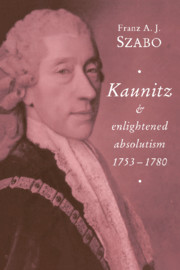3 - The structure of government
Published online by Cambridge University Press: 28 August 2009
Summary
The modernization of the Habsburg Foreign Office under Kaunitz was only part of a larger trend towards more professional forms of government in the eighteenth century. The principal feature of this incipient professionalization was increased bureaucratization, and it was the growth of professional impersonal bureaucracies that in turn became the leading edge of confrontation with more traditional indirect forms of government. By the eighteenth century this struggle already had a venerable history, but no decisive results. Nowhere in Europe had the great early modern conflict between emerging royal absolutism and intermediate feudal social corporations resulted in a decisive victory for either side. Eighteenth-century governments remained condominiums between a crown, increasingly articulating the concept of the impersonal state under its supreme authority, and feudal corporations stubbornly clinging to the patrimonial ideals of indirect rule through autonomous local authorities.
In this extended political struggle of the seventeenth and eighteenth centuries the Habsburg Monarchy remained in a rather peculiar position. A patrimonial conglomerate whose centrifugal particularisms were enhanced by constitutional, judicial, cultural and linguistic differences, it was legally bound together only by the Pragmatic Sanction which did little to enhance the authority of the crown over its subordinate social corporations. The great seventeenth-century victories of the crown were more confessional and cultural than political, and Habsburg Monarchs in the seventeenth and early eighteenth centuries were not “absolute” by any stretch of the imagination.
- Type
- Chapter
- Information
- Kaunitz and Enlightened Absolutism 1753–1780 , pp. 73 - 112Publisher: Cambridge University PressPrint publication year: 1994

